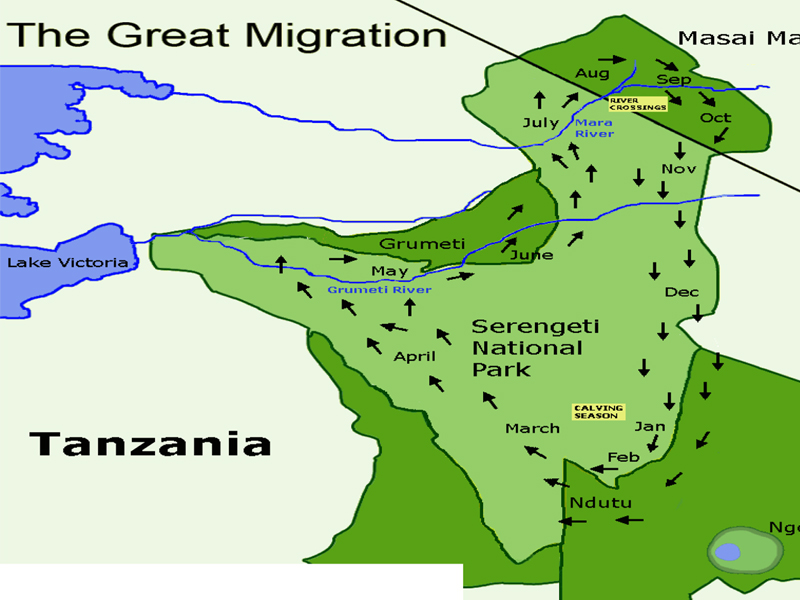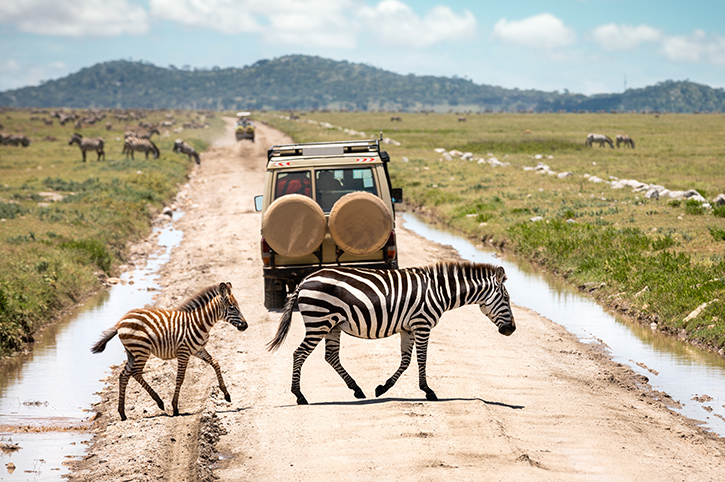Serengeti plains:
The endless, almost treeless grassland of the south is the most emblematic scenery of the park. This is where the wildebeest breed, as they remain in the plains from December to May. Other hoofed animals – zebra, gazelle, impala, hartebeest, topi, buffalo, waterbuck – also occur in huge numbers during the wet season. “Kopjes” are granite florations that are very common in the region, and they are great observation posts for predators, as well as a refuge for hyrax and pythons.
SERENGETI NATIONAL PARK
The Serengeti National Park in Tanzania was established in 1952. It is home to the greatest wildlife spectacle on earth - the great migration of wildebeest and zebra. The resident population of lion, cheetah, elephant, giraffe, and birds is also impressive. There’s a wide variety of accommodation available, from luxury lodges to mobile camps. The park covers 5,700 sq miles, (14,763 sq km), it’s larger than Connecticut, with at most a couple hundred vehicles driving around
The Park can be divided into 3 sections. The popular southern/central part (Seronera Valley), is what the Maasai called the “serengit”, the land of endless plains. Its classic savannah dotted with acacias and filled with wildlife. The western corridor is marked by the Grumeti River, and has more forests and dense bush. The north, Lobo area, meets up with Kenya’s Masai Mara Reserve, is the least visited section.
Two World Heritage Sites and two Biosphere Reserves have been established within the 30,000 km² region. It’s unique ecosystem has inspired writers from Ernest Hemingway to Peter Mattheissen, filmakers like Hugo von Lawick and Alan Root as well as numerous photographers and scientists - many of which have put their works at our disposal to create this website.The Serengeti ecosystem is one of the oldest on earth. The essential features of climate, vegetation and fauna have barely changed in the past million years. Early man himself made an appearance in Olduvai Gorge about two million years ago. Some patterns of life, death, adaptation and migration are as old as the hills themselves
It is the migration for which Serengeti is perhaps most famous. Over a million wildebeest and about 200,000 zebras flow south from the northern hills to the southern plains for the short rains every October and November, and then swirl west and north after the long rains in April, May and June. So strong is the ancient instinct to move that no drought, gorge or crocodile infested river can hold them back. The Wildebeest travel through a variety of parks, reserves and protected areas and through a variety of habitat. Join us to explore the different forms of vegetation and landscapes of the Serengeti ecosystem and meet some of their most fascinating inhabitants

African Buffalo: still abundant and present in healthy numbers, but numbers have been somewhat reduced due to disease.
The park also supports many other species, including cheetah, Thomson’s and Grant’s gazelle, topi, eland, waterbuck, hyena, baboon, impala, African wild dog, and giraffe. The park also boasts about 500 bird species, including ostrich, secretary bird, Kori bustard, crowned crane, marabou stork, martial eagle, lovebirds, and many species of vultures.

Western corridor: the “black cotton” (actually black clay) soil covers the swampy savannah of this region. The Grumeti River is home to enormous Nile crocodiles, colobus monkey, and the martial eagle. The migration passes through from May to July.
Northern Serengeti: the landscape is dominated by open woodlands (predominantly Commiphora) and hills, ranging from Seronera in the south to the Mara River in the border with Kenya. Apart from the migratory wildebeest and zebra (which occur from July to August, and in November), the bushy savannah is the best place to find elephant, giraffe, and dik-dik.
Wildlife
As well as the migration of ungulates, the park is well known for its healthy stock of other resident wildlife, particularly the “Big Five”, named for the five most prized trophies taken by hunters:
Lion: the Serengeti is believed to hold the largest population of lions in Africa due in part to the abundance of prey species. More than 3,000 lions live in this ecosystem.
African Leopard: these reclusive predators are commonly seen in the Seronera region but are present throughout the national park with the population at around 1,000.
African Elephant: the herds are recovering from population lows in the 1980s caused by poaching and are largely located in the northern regions of the park.
Black Rhinoceros: mainly found around the kopjes in the center of the park, very few individuals remain due to rampant poaching. Individuals from the Masai Mara Reserve cross the park border and enter Serengeti from the northern section at times.
